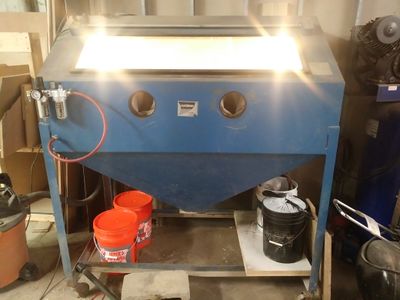Sandblasting Cabinet
Jump to navigation
Jump to search

This is a tool used to clean off metal parts.
Info
- Model: Unknown, but likely an older version of the Cyclone FT60
Internal Dimensions:
- Width: 58"
- Depth: 32"
- Height: 28"
External Dimensions:
- Width: 61"
- Depth: 36"
- Height: 68"
Parts:
- 3 In 1 Twin Air Filter Pressure Regulator Gauge Kit 3/8" Water/Oil Trap Separator - Amazon link
- Trigger-style blasting gun
Safety
- DO NOT EVER USE REGULAR SAND OR SILICA for sandblasting. Despite the name, you don't want to use sand because of a deadly disease called Silicosis, which happens from inhalation of silica.
- DO NOT BLAST PAINT THAT MAY CONTAIN LEAD. If you are not sure, use a lead test kit available at the hardware store. Lead dust is extremely toxic. Read more on the EPA's website.
- Make sure the seals on the machine are intact and effective, and the vacuum is turned on a filtering properly. Inhalation of abrasives can be very hazardous to your lungs.
Blasting Media
Common types that should be useful for most applications:
- Glass Bead 60-80 grit (20-60 PSI)
- Walnut Shell 18-40 grit (20-60 PSI)
- Black Beauty 20/40 mesh size
Guides and Manuals
- FT60 Manual (similar model)
- How to sandblast - everything you need to know.
- Excerpt: Sandblasting or abrasive blasting (also referred to as media blasting) is the operation of forcibly propelling a stream of abrasive material against a surface under high pressure to smooth a rough surface, roughen a smooth surface, shape a surface, or remove surface contaminants and paints/coatings. Compressed air is typically used to propel the blasting material (often called the media). There are several variants of the process, such as soda blasting, bead blasting, and shot blasting. To keep things simple, we will mostly refer to the generic terms “sandblasting” and “sandblaster”, although most of what follows applies all of the variants mentioned above.
- Abrasive Blasting Guide by Kramer Industries Online
Setup
- Inspect the equipment and parts:
- foam seals on doors, window, and gloves (intact, no visible gaps)
- vents (free of clogs)
- window (clean, not scratchy)
- blasting media (free of contaminants, check if appropriate for your application)
- nozzle and feed tube (remove feed tube and check for contaminants/clogs, ensure end of feed tube is at bottom of the funnel)
- Inspect vacuum:
- filter (free of clogs)
- hose (attached well at both vacuum chamber and back of cabinet, no holes in the hose)
- Connect power and air hose
- Insert part into cabinet
- Close doors tightly and properly
- Turn on vacuum
- Begin sandblasting
Replacement Parts
- 27" x 11.25" Window protector
- Door gasket - need to verify correct size
- Gloves
- Window 13" x 46.5"